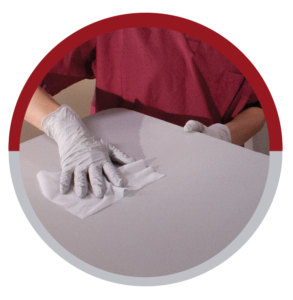Interventional Care


We notice that you are visiting us from . This site only services US-based visitors. Would you like to visit the site that is appropriate for your location?

The history of surface cleaning and disinfection is a fascinating story that dates back thousands of years ago, when Egyptians used wine or vinegar to clean.
Centuries passed and various chemicals have been used for cleaning. For instance, in The Odyssey, Homer wrote that the protagonist, after defeating his rival, demanded that Sulphur be burned in the house to detoxify and purify the space[1]. Mercury was also used for cleaning, and as a protectant for surfaces in many different cultures and eras[2]. While these were all somewhat archaic and sometimes toxic methods of achieving clean spaces, so little was known back then about bacteria and other microorganisms, it was thought that if you could see the chemical working (through smoke, or a coating on a surface), then it was killing the causative agent of the disease.
However, with Antonie Van Leuwenhook’s discovery of microorganisms in 1675, and his discovery that vinegar killed some of these microorganisms in 1676, scientists started realizing that these previously unseen organisms could be capable of causing disease, and in turn, chemicals could potentially kill these organisms without a visible reaction to the eye. This discovery opened the door for unlimited research in the study of the use of chemicals to kill microorganism(s) on a variety of surfaces and settings.
Phenols: Phenols, or phenolics, have been used as a hospital antiseptic and disinfectant since Joseph Lister used a phenol agent in his groundbreaking work on surgical antisepsis in the 1880’s. He used carbolic acid as the agent of choice in his research of sterilizing surgical instruments and wound cleansing, becoming the first antiseptic widely used in the surgical setting. However, with the discovery that phenols can be carcinogenic, and other chemicals being recognized as alternative agents, the use of phenols has greatly declined since the 1970’s, and are very rarely seen in the clinical setting today[3].
Quaternary Ammonium Compounds:Early in the 20th century, a new agent known as quaternary ammonium salts were first reported by the Rockefeller Institute in 1916 as having bactericidal properties. However, the use of quaternary ammonium compounds (QACs) as a germicide/disinfectant wasn’t formally recognized until 1935[4]. The first QAC on the market was benzalkonium chloride (BZK), which was initially introduced as an alternative to carbolic acid for skin antisepsis and scrub in the surgical setting. BZK showed such a significant reduction in skin flora, leading QACs to be further explored as a potential surface disinfectant [which was extremely successful.]
Unfortunately, QACS are usually low level disinfectants unless they are combined with an adjuvant chemical or are a more advanced generation of quat. Scientists began to combine disinfectants to see if there was any change in efficacy or the killing of the microorganisms. What they found was that when QACs were combined with alcohol, there was a synergistic change that allowed for a much faster kill of a broader spectrum of microorganisms, including Mycobacterium tuberculosis.* This allowed for the combination of QAC/alcohols to achieve intermediate-level disinfection status with the EPA and today, many hospitals prefer to use this QAC/alcohol combination, for its safety and efficacy attributes.
Bleach: In 5000 BC, Bleach was used as an agent to whiten clothes and other linens by the Egyptians[5]. In 1847, a bleach derivative was introduced as the hand disinfectant agent at the Vienna Medical Center to help reduce the risk of postpartum women who developed “Childbed Fever”, which had an 80% mortality rate. After introduction, the mortality rate plummeted to 90% the first month[6].
Bleach works in a similar fashion to that of alcohol. It will irreversibly denature the proteins of a bacteria, or depending on the pH of the bleach, penetrate the lipid membrane of the bacteria, causing it to “pop”, and the bacteria to die3. Thus, bleach is an extremely versatile disinfectant, especially in the healthcare setting – killing almost all pathogens, including spores. The Center for Disease Prevention and Control (CDC) recommends that a dilution of 1:10 bleach water be used in disinfecting surfaces that have highly transmittable, hard to kill pathogens like C. difficile or Norovirus[7].
Today, there are many disinfectants that can be safely used in the healthcare setting. However, there is always a give and take when it comes to using surface disinfectants. A disinfectant may be extremely effective at achieving the acquired log reduction and kill claims, but may be very harmful and degrading to surfaces. Every healthcare facility must decide what is best for their facility. PDI offers a variety of different EPA-registered surface disinfectants, as well as a compatibility program to help you find the right combination for your facility. To learn more, visit www.pdihctestindev.wpengine.com/compatibility.
1,2 History of Disinfection from early times to the end of the 18th century. J. Blancou. Rev. sci. tech. Off. int. Epiz., 1995,14 (1), 31-39
[3] Rutala, W., Weber, D., HICPAC. Guideline for Disinfection and Sterilization in Healthcare Facilities, 2008. Pg 51-52.
[4] Carl Lawrence. Surface-Active Quaternary Ammonium Germicides. Academic Press Inc. Publishers. New York. 1950.
[5] Chisholm, Hugh, ed. (1911). “Bleaching“. Encyclopædia Britannica (11th ed.). Cambridge University Press.
[6] Semmelweis, Ignaz (September 15, 1983) [1861]. Etiology, Concept and Prophylaxis of Childbed Fever. Translated by Carter, K. Codell. University of Wisconsin Press. ISBN0-299-09364-6
[7] The Centers for Disease Control and Prevention. Preventing Norovirus Infection. https://www.cdc.gov/norovirus/preventing-infection.html. Accessed 3/30/18.
*EPA Testing Methodology